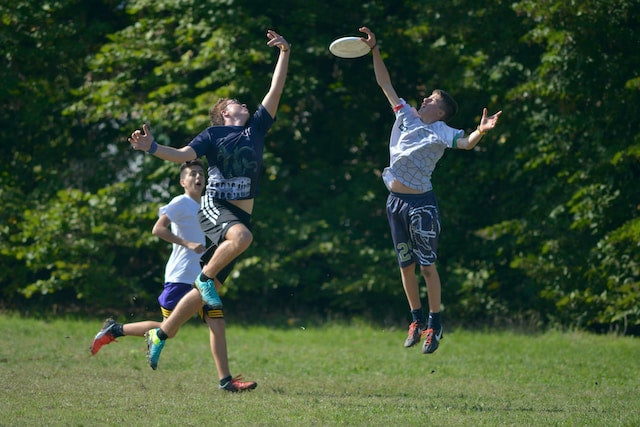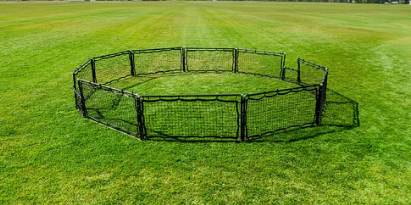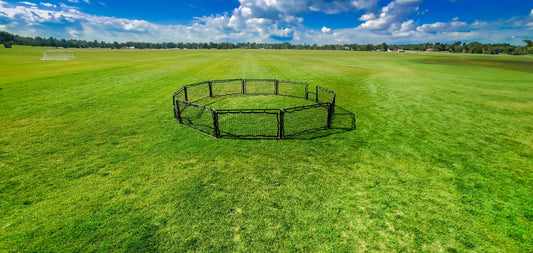This guide is not just a walk down memory lane; it's a treasure trove of innovative PE games designed to light up any large gathering with laughter and energy.
We're here to transform your view of physical education into an exhilarating adventure that goes beyond mere fitness. Each PE game is about more than just competition; they're a celebration of camaraderie, teamwork, and the sheer joy of movement. Our diverse lineup includes reimagined classics and fresh, engaging activities that promise not just a workout but a whirlwind of smiles, teamwork, and memories that stick for any field day
Whether you're leading a class, youth ministry, a sports team, or looking to spice up a large group event, our selected PE games for large groups are sure to inspire. They challenge conventions and bring out the collective joy of active play. Get ready for an experience where laughter is the soundtrack, loads of team spirit and fun reigns supreme.
Featuring five standout PE games perfect for energizing large groups.
Capture The Flag
Capture the Flag is popular when it comes to outdoor team building activities that has been enjoyed by generations of players worldwide. It's a thrilling and strategic game that involves two or more teams competing to capture the opposing team's flag while defending their own.
Here's how the game typically works:
Setting up the Field: The game is usually played in a designated outdoor play area, like a park, field, or large playground. The playing area is divided into two equal parts, one for each team. Each team of smaller group has a "home base" where they place their flag.
Flags and Territories: Each team has a flag, which is a piece of fabric or a marker representing their territory. Players can create some kind of shelter to guard their flag from the other team using props such as Infinets. The objective is to capture the enemy team's flag and return it to their own home base without getting tagged.
Team Composition: Divide Participants evenly, and each player wears a distinctive colored armband, shirt, or something that identifies their team. They need to work together to reach the common goal, no one player will be able to tackle this alone. This is where Team bonding and team work is crucial.
Game Rules: The game begins with both teams at their respective home bases. Players are not allowed to cross into the opposing team's territory unless they are attempting to capture the flag.
Capturing the Flag: The goal is to sneak into the enemy's territory undetected, grab their flag, and return it to your home base without being tagged (touched) by the defending team. If an opposite team player is tagged while in the enemy's territory, they must go to a designated "jail" area.
Jail and Rescuing: Players sent to jail are held there until they are "rescued" by a teammate. A teammate can free jailed players by touching them, allowing them to return to their home base.
Winning the Game: The game ends when one team successfully captures the other team's flag and brings it back to their own home base without being caught. Alternatively, a time limit can be set, and the team that captures the most flags during that time wins.
Capture the Flag is not only a thrilling test of team dynamics and teamwork but also a fun way to promote physical activity and social interaction. This excellent hybrid of a tag game and strategic activity allows for diversity of interest for each student. It encourages players to communicate, plan tactics, achieve leadership skills and work together to achieve a common goal, making it an enduring favorite among kids, teenagers, and even adults in various settings, such as schools, camps, church youth group and community events. This also allows for the perfect large group game because of its limitless potential for the number of team members.
9 Square

9 Square is an exciting and fast-paced group game that combines elements of volleyball and handball. It is typically played with nine squares arranged in a 3x3 grid, hence the name "9 Square."
9 square castle squares outside
Here's how the game is played:
Setting up the Game: A 3x3 grid of squares is created using poles or freestanding structures. Each square is about 4 to 5 feet wide and is connected by a net or a rope, creating nine separate player areas.
Player Positions: Each square is assigned a player, and each participant stands inside their designated squares at the beginning of the game. Although this game can be played in small teams or large teams, 9 players is the minimum.
Object of the Game: The objective of Nine Square is to eliminate players from the squares above you by hitting the ball into their squares, causing them to make an error, or letting the ball bounce in their square without catching it.
Gameplay: The game starts with a designated player serving the ball into one of the squares. Players must hit the ball with their hands, sending it into an opponent's square. The receiving player must then hit the ball into another square within one or two touches, and so on.
Rules: There are specific rules governing how players can hit the ball and what constitutes an "out." For instance, players must hit the ball with an open hand and can't carry, lift, or double-hit the ball. If a player commits an error, they are eliminated from the game, and the remaining players move up to fill the vacant square.
Rotation: After a player is eliminated, the remaining players rotate to fill the empty square. The player who was in the top square usually moves to the back of the line to wait for their turn to re-enter the game.
Winning: The last player remaining in the top square is the winner. Depending on the setting, the game can be played in a single round or as a series of rounds to determine the overall champion.
9 square is a fun activity that is inclusive and can be enjoyed by people of all ages and skill levels in PE class or group gathering. It promotes quick thinking, friendly competition, agility, and hand-eye coordination while providing an energetic and enjoyable experience for everyone involved. It has become a popular PE activity at schools, camps, youth group game, and community events due to its simplicity, versatility, and opportunity to develop skill in fun team bonding activities.
Kickball

Kickball is a popular game to add to your list of outdoor team building activities. It is sport that shares similarities with baseball and soccer. It is often played by children and casual players, but there are also organized leagues for adults who enjoy a more relaxed and social sporting experience with the benefit of fun team building activities.
Here's how the game is played:
Setting up the Field: Kickball is typically played on a softball or baseball field, but it can also be adapted to other open spaces. The field has bases, including a home plate, first base, second base, third base, and an outfield.
Equipment: To play kickball, you need a rubber or inflatable ball, similar in size to a soccer ball or dodgeball. Players also need a designated kicking area, usually marked in front of home plate.
Team Composition: Kickball is usually played with two teams, each consisting of several players. The number of players on each team can vary but is often around 9 to 11 players. With larger groups, divide students into 2 equal teams to have the most even play experience.
Gameplay: The game begins with one team member in the field, and the other team members at bat. The team at bat kicks the ball from home plate and then tries to run around the bases, similar to baseball. The fielding team's goal is to catch the ball and tag the runners to get them out.
Rules: The rules of kickball are similar to baseball, with a few notable differences. In kickball, the pitcher rolls the ball toward the kicker, who must kick the ball with their foot. The kicker then becomes a runner and tries to reach the bases and eventually return to home plate. Runners are allowed to advance to the next base after a successful kick.
Outs and Scoring: Players are called "out" if they are tagged with the ball while running between bases, if a fielder catches their kicked ball before it touches the ground, or if they are forced out at a base when the defense has control of the ball. The game progresses with each team taking turns to bat and field until a predetermined number of innings are completed.
Winning: The team with the most runs scored at the end of the game is declared the winner.
Kickball is popular because it requires minimal equipment, is easy to understand, and can be played by people of all ages and skill levels. It encourages physical activity, teamwork, and friendly competition, making it an enjoyable game for social gatherings, school recess, summer camps, and community events each the craze of all competitive students.
Red Rover
Red Rover is a traditional children's playground game that is both a fun game and physically engaging. It is often played outdoors and requires a large open space, such as a grassy field or playground. More often then not this game is designed for a younger child or group of early teenagers because of the safety of players.
Here's how the game is played:
Setting up the Game: Divide participants into two equal teams, and each team forms a line, facing each other, at a distance of about 30 to 50 feet apart.
Choosing a Caller: One team member goes first and selects a "caller" from their group. The caller's role is essential, as they will be the one calling out the name of a player from the opposing team to come over. This allows leadership skills to be developed to the caller.
Gameplay: The game starts when the caller from one team calls out "Red Rover, Red Rover, send [player's name] right over!" The named player from the opposing team then has to run as fast as they can toward the other team's line and attempt to break through their linked hands.
Breaking the Chain: The objective of the player running is to try and break through the linked hands of the other team. If they succeed in breaking the chain at any point, they get to choose one player from the opposing team to take back to their team. This captured player joins the opposing team for the remainder of the game.
Defending the Chain: If the player running fails to break the chain, they must join the team they tried to break through, and the game continues with the next player from the same team trying to break through the opposing line.
Winning: The game continues until all players are on one team, and there are no more players left to call over. The team with all the players is the winning team
Red Rover is a game of strength, strategy, and teamwork. It encourages physical activity, quick decision-making, and cooperation among players. This game brings healthy competition to the entire team as they work together. This could be one of many great warm up games to prep players for a more involved activity if needed. However, due to the potential for collisions or injuries, it is essential to play the game safely and have adult supervision, especially with a young person. Red Rover is a classic and timeless game that has been enjoyed by generations of children and is often played during school recess, at summer camps, and in neighborhood gatherings.
Gaga Ball

Gaga Ball works great as both an indoor and outdoor team building activity. It's a game that is similar to dodgeball where you get out if the ball hits you below the knee or if you hit the ball out of the pit. If you're the last person standing then you've won the game. This game is set up by using Infinets assembles in a circle to create a pit. The game is played with 6-8 participants starting inside the pit and all other players outside of the put. One player from outside the pit throws a ball in and the common goal is to not let it hit you. Each player can use their hands to hit the ball away from them aiming to hit another player below the knees. If the player hits them above the knees, out of the pit, or gets hit below the knees by another player then they are out and must exit the pit. The game goes on until there is one player left, and that player is the winner.
This is a great game to get big or small groups moving, it gives a similar feel as a relay race due to the fast thinking and quick acting culture of the game. This encourages strategic thinking and team dynamics in a new way. weather this is a school, home or youth group game there is endless fun and minimal set up allowing you to play whenever, wherever!
Ultimate Frisbee

Ultimate Frisbee, often simply called "Ultimate," is a fast-paced, non-contact team sport that combines elements of soccer, football, and basketball with the flying disc (Frisbee). It is played on a rectangular field with two end zones, and the objective is to score points by catching the Frisbee in the opposing team's end zone. This should always be included in a PE teacher lists of team building games.
Here's how the game is played:
Teams: Ultimate is typically played with two teams, each consisting of seven players on the field. However, the number of players can vary depending on the setting and the level of play. If you have a smaller team it may make it more challenging and if you have a large group you can create more then 2 teams and rotate them.
Starting Play: The game begins with a "pull," where one team throws the Frisbee to the other team, similar to a kickoff in football. The receiving team catches the Frisbee and becomes the offense, while the other team becomes the defense.
Movement and Scoring: The offensive team's objective is to advance the Frisbee down the field by passing it amongst their players. Players cannot run with the Frisbee; they must establish a pivot foot while holding it. The ultimate goal is to catch the Frisbee in the opposing team's end zone, which results in a score worth one point.
Turnovers: If the Frisbee is dropped, intercepted, goes out of bounds, or the defense blocks the pass, possession of the Frisbee switches to the other team, and they become the offense.
Non-Contact: One of the unique aspects of Ultimate is that it is a non-contact sport. Players are not allowed to physically block or impede their opponents. Instead, defense is based on positioning, anticipation, and attempting to intercept or block passes.
Scoring: The game is usually played to a predetermined score, and the team with the most points at the end of the game is declared the winner. Depending on the setting, games can be played to a certain number of points or with a time limit.
Spirit of the Game: A significant aspect of Ultimate Frisbee is the emphasis on sportsmanship and team spirit. Players are expected to uphold a high level of fair play, respect, and integrity, even without referees. Disputes are resolved amicably among the players involved in this team building game.
Ultimate Frisbee is a popular sport played at various levels, from casual pick-up games to competitive tournaments and leagues. It promotes physical fitness, teamwork, team morale and strategic thinking while fostering a welcoming and inclusive community. The sport's self-officiating aspect and emphasis on good sportsmanship make it a unique and enjoyable experience for participants of all ages and skill levels. This is also one of the many great cooperative games to help build a bond between your players.
Wrapping up our journey through the vibrant landscape of PE games for large groups, it's evident these activities are much more than just physical exertion or competition. They're a celebration of togetherness, a forge for enduring bonds, and a catalyst for the pure delight of collective play.
From the strategic dashes in Capture the Flag to the cooperative spirit of 9 Square, down to the timeless joy of Kickball, each game introduces a distinctive charm. They push us to move, think, and communicate, carving out essential life skills amidst bouts of laughter and high spirits. The true magic of these games lies in their universal appeal, bridging gaps across ages, backgrounds, and skill levels. They transform any gathering—be it a school field, a camp, or a community festival—into a melting pot of joy, inclusivity, and mutual triumph. So, whether you're orchestrating a large event, a team-building session, or simply aiming to draw a crowd closer, sprinkle in these PE gems. Lean into the fun, kindle the flame of friendly rivalry, and watch as an extraordinary wave of happiness washes over your group.
Here's to the enduring charm of large group PE or youth group games where laughter fills the air, smiles are in abundant supply, and memories to be treasured for years to come are made. Discover a personal hidden talent and improve your problem solving skills by maintaining a connection with each team member. Gather your crew and dive into the endless fun—here, the games are just the beginning, and the joy they bring knows no bounds. Let the games commence, and may the spirit of play live on forever.







